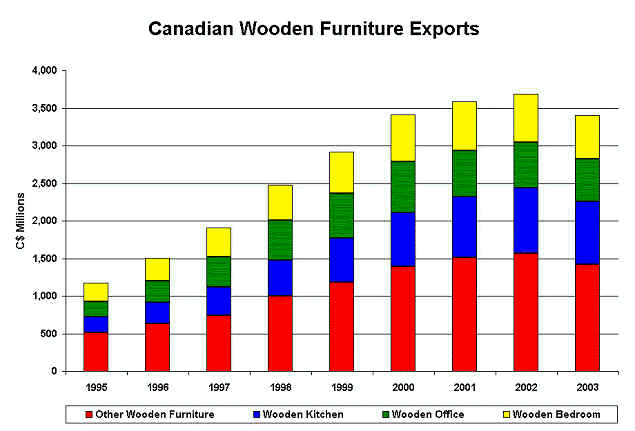|
|
|
|
|
|
 |
|---|
|
What's New? | Trade Data | Country Reports | Market News | Trade Policy | Publications | Coming Events | Helpful Links |
|
|
FOREST PRODUCTS MARKET NEWS - MARCH 2004 | |||||||||||||||||||||||||||||||||||||||||||||||||||||||||||||||||||||||||||||||||||
| America's Largest Market Increases its Demand for U.S. Wood U.S. Solid Wood Exports to Canada Grow 6.5 Percent in 2003 By William Bomersheim, Agriculture Marketing Specialist |
||||||||||||||||||||||||||||||||||||||||||||||||||||||||||||||||||||||||||||||||||||
| The United States exported more than $1.79 billion of solid wood products to Canada in 2003, up 6.5 percent from 2002. U.S. exports of hardwood lumber, hardwood veneer, hardwood logs, builder’s carpentry, and softwood logs each set new record highs. A strong economy underpinned by a housing boom and robust consumer demand has propelled Canadian demand for solid wood ever higher. | ||||||||||||||||||||||||||||||||||||||||||||||||||||||||||||||||||||||||||||||||||||
 |
||||||||||||||||||||||||||||||||||||||||||||||||||||||||||||||||||||||||||||||||||||
| Strong Macro-economic Fundamentals Strong economic fundamentals including an expanding GDP, low unemployment, low inflation, and low interest rates have created the conditions for increased solid wood demand. In the third quarter of 2003, Canadian GDP expansion resumed, while real personal disposable income rose 1.4 percent and real personal disposable income per capita rose to a record, nearly 14 percent above the 1996 level. Unemployment fell from over ten percent in the mid 1990s and has remained under eight percent since 1999. By January unemployment had fallen to only 7.4 percent. At the same time, inflation recorded in January at only 1.2 percent, has remained under control. This has enabled the Bank of Canada to lower the Overnight Rate Target to 2.5 percent, driving the prime interest rate to just 4.25 percent.1 |
||||||||||||||||||||||||||||||||||||||||||||||||||||||||||||||||||||||||||||||||||||
 Source: Statistics Canada |
||||||||||||||||||||||||||||||||||||||||||||||||||||||||||||||||||||||||||||||||||||
| Record Housing & Renovation Activity Low interest rates coupled with rising employment has resulted in a building boom. Annual housing starts in 2003 were at their highest level since 1998. Total housing starts for 2003 are estimated at 217,800, 6.2 percent above 2002. The value of building permits also set a new record as municipalities issued C$50.8 billion ($38.2 billion) in residential and non-residential permits. Permits in the housing sector were more than C$32 billion ($24 billion), eight percent above the previous record of C$29.6 billion ($22.3 billion) set in 2002.2 It was the eighth consecutive year in which the value of permits increased. |
||||||||||||||||||||||||||||||||||||||||||||||||||||||||||||||||||||||||||||||||||||
|
Value of Building Permits by Type
|
||||||||||||||||||||||||||||||||||||||||||||||||||||||||||||||||||||||||||||||||||||
In addition, housing renovation, a vital part of the housing industry, has been on an upward trend since 1996. According to the Canada Mortgage and Housing Corporation's (CMHC) 2003 housing outlook report, renovation spending was expected to increase from C$29.8 billion ($22.4 billion) in 2002 to a new record of over C$32 billion (24.1 billion) in 2003. A further increase in renovation activity is forecast for 2004. Renovations, including room additions, new kitchen cabinets, and other remodeling increase demand for U.S. wood products, especially, American hardwoods. |
||||||||||||||||||||||||||||||||||||||||||||||||||||||||||||||||||||||||||||||||||||
| Strong Furniture Sector Finally, demand for U.S. solid wood products has also been driven by a healthy Canadian furniture sector. Canadians, confident about their jobs, have generally increased spending on durable goods. However, as the housing market has remained buoyant, Canadian furniture spending has led all other retail sectors in sales growth in 2003 and in every year since 1998. Canadian furniture purchases rose 11.6 percent in 2002, and another 6.5 percent in 2003. Additionally, Canadian furniture manufacturers have been able to double furniture exports since 1995. Canada is the third largest furniture exporter in the world following China and the United States.3 Slightly more than one-half of all Canadian furniture production is exported.4 |
||||||||||||||||||||||||||||||||||||||||||||||||||||||||||||||||||||||||||||||||||||
 |
||||||||||||||||||||||||||||||||||||||||||||||||||||||||||||||||||||||||||||||||||||
Canadian Index of Leading Indicators
|
||||||||||||||||||||||||||||||||||||||||||||||||||||||||||||||||||||||||||||||||||||
| Source: Statistics Canada | ||||||||||||||||||||||||||||||||||||||||||||||||||||||||||||||||||||||||||||||||||||
| Outlook for 2004 The outlook for U.S. wood products exports to Canada in 2004 is good. The Canadian composite of leading indicators rose 0.6 percent in January, as Canadian manufacturing took the lead in growth. Overall, six of the ten components rose in January. Most notably, the furniture and appliance sales index rose, although the housing index fell due to inclement weather. However, most economists are forecasting continued strength in the housing sector for 2004, with low interest rates and continued income growth. Canadian demand for U.S. wood used in housing components and interior applications, as well as demand for furniture and other furnishings is expected to remain strong. In addition, an upturn in the U.S. economy is expected to boost demand for Canadian goods, including furniture, thus spurring Canadian demand for U.S. solid wood products. |
||||||||||||||||||||||||||||||||||||||||||||||||||||||||||||||||||||||||||||||||||||
|
1 When the Bank of Canada changes its Overnight Rate Target, this usually leads to changes in the "prime rate," which is set by commercial banks. The prime rate is the reference point for interest rates charged on many mortgage, personal, and business loans, as well as interest paid on deposits and investment certificates. |
||||||||||||||||||||||||||||||||||||||||||||||||||||||||||||||||||||||||||||||||||||
| Last modified: Friday, January 19, 2007 |